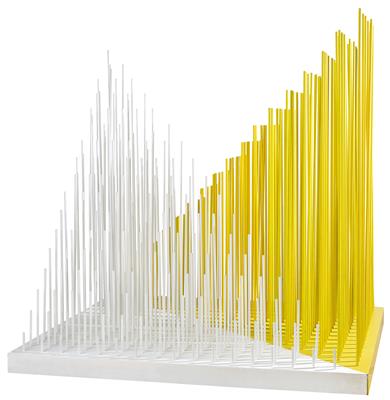Jesus Rafael Soto *

(Cuidad Bolivar 1923–2005 Paris)
Progressione bianca e gialla, 1968, painted iron, 152 x 149 x 149, (MCC)
Photo certificate:
Hélène Soto, Paris, 22 July 2008, ref. no. 80672293
Provenance:
Atelier of the Artist, there acquired by Galleria Marlborough, Rome, 1968
Galleria Marlborough, Rome - New York
C. Panicali di Montalto Collection, Rome
European Private Collection
Exhibition:
Rome, Soto, Galleria Marlborough, 1968
Bergamo Soto Galleria Lorenzelli, 1968
New York, Soto unearthed - A 1968 Film and selected early Works, Bosi Contemporary, October - December 2012, exh. cat. p. 46 with ill.
The Venezuelan artist, who became universally famous for his works of kinetic art made with plastic, plexiglass and other materials, has always animated his sculptures through movements— vibrations that were often originated by his audience’s own gestures; in his mature years he created habitable pieces on an architectural scale. Soto became a well-known artist for his sculptures made of threads and dangling, moving tubes, permeated by pure, absolute colours, which are often positioned next to a white section as an explicit reference to the artist’s studies of Kandinsky and Mondrian.
This work has a square base that is very close to being perceived as a rectangular. It is divided diagonally into two triangles, in a comparison that hosts white and yellow threadlike elements, juxtaposed and ready to vibrate. A reference to such basic forms – the square, the rectangle, the triangle – is typical of the architecture of the 1960s and 1970s, in particular of the work of the great American architect Louis Kahn, who – during those decades – overhauled the concept behind the modern project through an exaltation of geometry. It is not by accident, then, that most visual artworks of that period, like this one by Soto, contain a reference to that architectural season in their relying on an extremely pure and absolute geometric conception of space. Such forms also have a clear symbolic meaning: squares and rectangles are a reference to living space – the house, the building; they firmly circumscribe a space; they are an invitation to settle down. On the contrary, a triangle creates positive tensions, balancing forces that are different from one another and that would otherwise clash; where squares and rectangles are absolute, the triangle is relative. From this perspective, squares and rectangles can either be shelters or prisons, while the triangle evokes a dynamic dimension, open to imperfections. Where the first two forms proceed to generate house and church, the triangle creates the tent, a more human-sized space. Soto fills his two triangles with his threadlike, vivid elements, coloured in white and golden yellow, with an unmistakeable reference to the Baudelairian “forest of symbols”, with all its mysteries and conundrums of life and reality.
Daniela De Angelis
Expert: Maria Cristina Corsini
 Maria Cristina Corsini
Maria Cristina Corsini
+39-06-699 23 671
maria.corsini@dorotheum.it
25.11.2015 - 18:00
- Odhadní cena:
-
EUR 280.000,- do EUR 350.000,-
Jesus Rafael Soto *
(Cuidad Bolivar 1923–2005 Paris)
Progressione bianca e gialla, 1968, painted iron, 152 x 149 x 149, (MCC)
Photo certificate:
Hélène Soto, Paris, 22 July 2008, ref. no. 80672293
Provenance:
Atelier of the Artist, there acquired by Galleria Marlborough, Rome, 1968
Galleria Marlborough, Rome - New York
C. Panicali di Montalto Collection, Rome
European Private Collection
Exhibition:
Rome, Soto, Galleria Marlborough, 1968
Bergamo Soto Galleria Lorenzelli, 1968
New York, Soto unearthed - A 1968 Film and selected early Works, Bosi Contemporary, October - December 2012, exh. cat. p. 46 with ill.
The Venezuelan artist, who became universally famous for his works of kinetic art made with plastic, plexiglass and other materials, has always animated his sculptures through movements— vibrations that were often originated by his audience’s own gestures; in his mature years he created habitable pieces on an architectural scale. Soto became a well-known artist for his sculptures made of threads and dangling, moving tubes, permeated by pure, absolute colours, which are often positioned next to a white section as an explicit reference to the artist’s studies of Kandinsky and Mondrian.
This work has a square base that is very close to being perceived as a rectangular. It is divided diagonally into two triangles, in a comparison that hosts white and yellow threadlike elements, juxtaposed and ready to vibrate. A reference to such basic forms – the square, the rectangle, the triangle – is typical of the architecture of the 1960s and 1970s, in particular of the work of the great American architect Louis Kahn, who – during those decades – overhauled the concept behind the modern project through an exaltation of geometry. It is not by accident, then, that most visual artworks of that period, like this one by Soto, contain a reference to that architectural season in their relying on an extremely pure and absolute geometric conception of space. Such forms also have a clear symbolic meaning: squares and rectangles are a reference to living space – the house, the building; they firmly circumscribe a space; they are an invitation to settle down. On the contrary, a triangle creates positive tensions, balancing forces that are different from one another and that would otherwise clash; where squares and rectangles are absolute, the triangle is relative. From this perspective, squares and rectangles can either be shelters or prisons, while the triangle evokes a dynamic dimension, open to imperfections. Where the first two forms proceed to generate house and church, the triangle creates the tent, a more human-sized space. Soto fills his two triangles with his threadlike, vivid elements, coloured in white and golden yellow, with an unmistakeable reference to the Baudelairian “forest of symbols”, with all its mysteries and conundrums of life and reality.
Daniela De Angelis
Expert: Maria Cristina Corsini
 Maria Cristina Corsini
Maria Cristina Corsini
+39-06-699 23 671
maria.corsini@dorotheum.it
|
Horká linka kupujících
Po-Pá: 10.00 - 17.00
kundendienst@dorotheum.at +43 1 515 60 200 |
| Aukce: | Současné umění |
| Typ aukce: | Salónní aukce |
| Datum: | 25.11.2015 - 18:00 |
| Místo konání aukce: | Wien | Palais Dorotheum |
| Prohlídka: | 14.11. - 25.11.2015 |
Všechny objekty umělce
